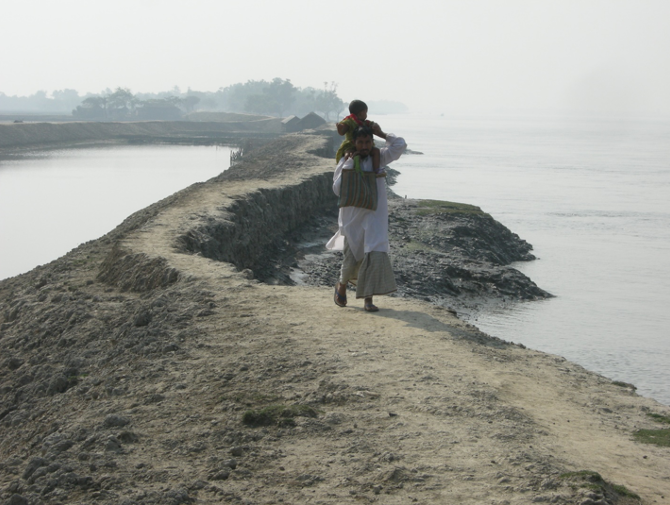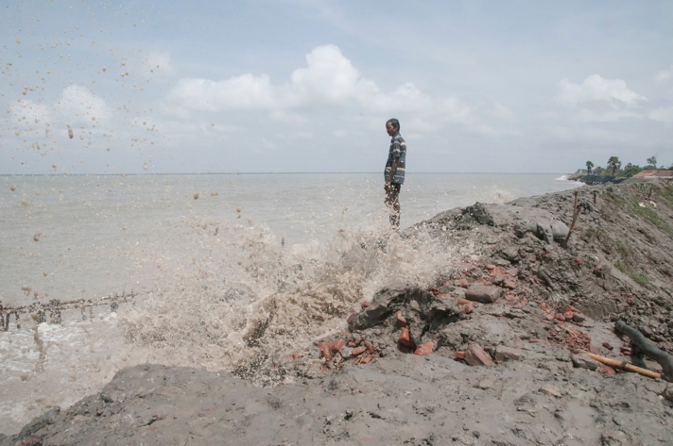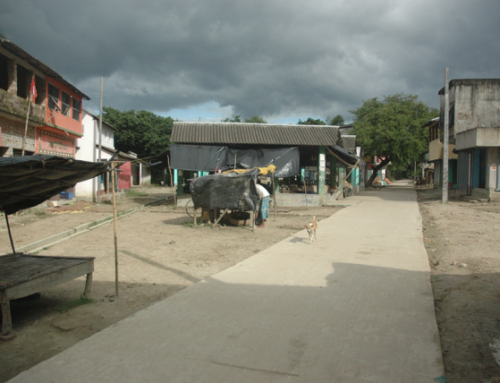With the Category 5 cyclone Amphan hurtling towards first the Sundarbans, then Kolkata, and the rest of Bengal in May, both of us, scholars who have been working on the Sundarbans for more than two decades, started calling our friends and acquaintances. We learned that our long-time interlocutors, Sumati and Hori, both in their mid-fifties, and Rubina and Shahid, in their mid-forties, would be spending the night packed like sardines in local schools. They hoped that the brick structures would hold against the 185 km (111 mile) per hour winds that would lash their respective low-lying islands and perhaps break the ring embankments that protect their homes, lands, and ponds from the brackish river waters. When cyclones hit the Sundarbans, mud huts’ bases risk dissolving either in the torrential rains or in the sudden surges caused by embankment collapse, and straw or asbestos roofs then fall to the ground; roofs also risk being carried away by the fury of the winds. The severe cyclonic storm Aila, which struck the Sundarbans back in 2009, killed 340, caused the “disappearance” of 8000, and left more than a million homeless across the Indian state of West Bengal and the adjoining country of Bangladesh. Aila’s devastation forced Sumati as well as her sons to leave the Sundarbans in search of work elsewhere in India. Cyclone Amphan may have seemed unique, but the modus operandi was a recurring one.

An earthen embankment breached by saline floodwaters following cyclone Amphan in Lahiripur village in the West Bengal Sundarbans. Photo by Ayan Ghosh. (India)
After cyclone Aila, millions of young men, sometimes with their young families, left the Sundarbans in search of work in India’s big cities. Over the years, the Sundarbans had worn a relatively deserted look as the younger and middle-aged members of families started migrating out (with some frequently and others infrequently returning home during their break). However, if Aila had forced mainly young people to migrate out, the pandemic Covid-19 and India’s ill-planned sudden and total “lockdown” was making them return. Sumati, who worked as a nurse in one of Kolkata’s better-off households, found herself ill with fever and a bad cough three days after the lockdown. She had caught “a cold” from the family where she worked, but they forced her to leave. With no means of transportation available, returning to her village rapidly turned impossible. Would she have to live on the streets? She somehow managed to return home and quarantined herself for two weeks. Her job had ensured the steady supply of the life-saving medicines her ailing husband needed; now with her job gone, they had no means of continuing his treatment, and his health was hastily deteriorating. Over the coming weeks, her sons also lost their jobs and started to make the long way back home with their young families. Teenagers who had left villages to pursue dreams of a better life in the city were walking back home on May 20, the day that cyclone Amphan struck the region. They walked empty-handed with the foreboding knowledge that the storm would certainly shatter embankments, inundate their land and ponds, and – with its salt – wreak havoc on any life that could have tided them over the coming months.

Children play in the floodwaters of cyclone Amphan on Mousuni island in the West Bengal Sundarbans. Photo by Abhijit Chakraborty, Shudhu Sundarban Charcha. (India)
The Sundarbans are an immense archipelago of islands stretched in a semi-circle across the mangrove delta north of the Bay of Bengal. The inhabited islands closest to the forest are part of the active delta and have the reputation of “moving” – as Amitav Ghosh described these islands beautifully in his books Gun Island. Large scale deforestation for revenue purposes under the British about two hundred years ago paved the way for these islands to be “settled” by humans. By the end of nineteenth and early twentieth centuries, only the islands where people had managed to erect bunds (embankments – usually of mud), became habitable1. The islands that were left untouched, remained forested and inhabited by wild animals, the most famous of which are the Royal Bengal tigers. These islands continue to be flooded by the brackish water tides and go under water twice a day during high tide. This watery landscape, so vulnerable to the shifting currents of rivers and frequent cyclonic storms, can only be “habitable” when surrounded by protective embankments – “life-lines” that keep the surrounding salt water at bay. Once these are breached, all life that sustains human life ends – ponds that provide fish suddenly become cesspools of poison, land that is usually fertile becomes barren for three to five years, and huts built with great precaution dissolve into the vast stagnant expanse of rotting grey.

A man carrying his baby walks along a mud embankment at Kamalkathi, 25 kilometers north of the Sundarbans. This is an example of how the river (here the Morrichap) “eats” into the embankment. One can see a second inner ring embankment in the distance protecting the island. Photo by Annu Jalais. (Bangladesh)
The Sundarbans islanders are not unfamiliar with cyclonic storms. It is in this sense that the impact of Amphan is no different from that of earlier ones, such as Sidr (2007), Aila (2009), Phailin (2013), Hudhud (2014), and Bulbul (2019). However, Amphan struck in Covid-19 times. On the fateful night of the cyclone, young mothers with their children, the fit, as well as the elderly, all left their mud huts to pack together in brick shelters at a time when physical distancing was being promoted to prevent and control the pandemic. The cyclone hammered the islands for five long hours, tearing through everything that people could call their own. The media reported on uprooted trees and the snagged power lines of Kolkata, providing practically no news of the islands that lay directly in Amphan’s path during the five days that followed the cyclone. The telephone towers were down and those walking back, or those who lived on other islands or in the suburbs of Kolkata, were sick with worry for their families. The central government declared relief to the tune of 10 billion INR or 154 million US dollars. However, for nearly a month after the cyclone, many continued to spend their nights either in the crowded cyclone shelters or under makeshift plastic-sheets tied to four poles that act as open “tents” on the still-raised parts of the embankments that were not broken. A recent report revealed how the beneficiaries of state compensation from the wreckage caused by the cyclone were mainly the ruling party functionaries’ families and supporters, causing a lot of anger and distress amongst those who were most affected.
The informal sector, the migrant worker, and the pandemic “lockdown”
The outbreak of the Covid-19 pandemic and resultant loss of employment for the poorest has revealed the fundamental divide between India’s formal sector, consisting of government bodies and the corporate sector (10% of the population), and the proliferating informal sector overlapping with a crumbling agricultural sector (together 90% of the population). This gulf roughly corresponds to India’s middle-class society on one hand, with stable incomes and decent savings, and informal workers who struggle for their daily subsistence, a pittance, on the other. The lockdown was announced with just four hours to spare, and the entire informal sector took a blow. The migrant population, consisting of 450 million or 37% of India’s 1.3 billion people, found itself stuck in big cities with neither a way of returning home nor one to make a living. The country witnessed appalling scenes of millions of desperate people amassed at railway stations, climbing onto loaded trucks, or simply walking on highways and along railway lines, while the media and the government simply looked the other way. The government’s economic “Stimulus Package” was a giant “confidence trick,” as nearly 100 million daily wage earners had lost their jobs by mid-May. Flights were organized for students and middle-class workers stranded overseas, but nothing was done to alleviate the agony of the migrant workers of India’s sprawling cities. Visuals of migrants dying of hunger, killed by trains while asleep across tracks out of sheer exhaustion, and even a young mother lying dead on a railway platform while her toddler attempted to wake her up, did not seem to stir the Modi government from its callous indifference towards India’s unfortunate and destitute: approximately 460 million people2.
Since May, this fundamental divide has expressed itself in the realm of the economy, where instead of acting upon “the tragedy unfolding on our highways, several state governments set about ‘reforming’ labour laws by quite literally doing away with crucial protections in a bid to make themselves more attractive to business” remarked, “When politics is suspended, those in the informal sector count for nothing. (…) Contrary to what some people believe, it is politics that ensures a degree of decency and compassion in the public life of this country. Without it, those in power are free to look after their own kind and declare the rest of the population redundant. It took a pandemic to demonstrate this simple truth.”
Just as the migrants from the Sundarbans began to lose their jobs and return home, their counterparts in the delta were suddenly facing the double threat of losing their land, ponds, and homes to Amphan, and their jobs, health, and lives to the lockdown and Covid-19. All of those from the islands nearest the forest who depended on the tourism-related informal sector had been out of work since the start of the lockdown, and those living on islands where the embankments had broken were now homeless. “I do not see any future, the disease and Amphan destroyed us, I don’t know what will happen to my children,” Rubina Laskar broke down as we spoke over phone. Rubina was among those who lost their jobs at a tourist lodge in Jharkhali because the owner was forced to shut it after the lockdown. She, like countless others, will have to start fishing along the embankments and in the creeks of the forests to feed her starving children and elderly parents-in-law. Since the initial lockdown in March, increasing numbers of Sundarbans islanders have been forced to enter the forest to fish, poach deer, or collect firewood to stave off starvation. Already, nineteen people have been killed by tigers in the West Bengal part of the Sundarbans alone. In comparison, for the whole of 2019, the number of tiger victims was ten, and for 2018 the number was five.3 Those killed by crocodiles rarely make it to the media. But what option does Rubina have?
Of disasters, vulnerability, and resilience
After Cyclone Aila in 2009, the World Bank allocated a colossal Rs 5,032 crore (670 million USD) to the Sundarbans Embankment Reconstruction Project to rebuild embankments, yet stretches of embankment lay broken many years after. Breached embankments present the opportunity for government officials, engineers, and their appointed contractors to make money. The process of rebuilding embankments involves the acquisition of land, which results in cyclone victims forever losing their lands, ponds, and houses with no (or too little or tardy) compensation coming their way. What happens in the name of embankment construction is a shoddy patchwork that demonstrates entrenched corruption and a lack of engagement with on the ground necessities. In this sense, Amphan is both unique and recurrent, unique in terms of its occurrence finding in the pandemic a natural ally, and recurrent in that it produces conditions of vulnerability in exactly the same way as all the earlier cyclones did. Thus, it is the aftershocks of disaster that tell us a great deal about the social and political context of disasters and people’s suffering rather than a cyclone that lasts a few hours. Drawing parallels with the aftershocks of a hurricane in Puerto Rico, described by Bonilla and LeBrón (2019), we would like to argue that here too state failure, social abandonment, capitalization on human misery, and the collective trauma produced by the botched response have brought the Sundarbans islanders to the brink of a perhaps greater disaster. Because this time, the necessary physical distancing needed to keep Covid-19 at bay, makes solidarity an even more difficult feat to achieve.

Incoming tides threaten a newly-repaired, fragile earthen embankment on Mousuni island in the West Bengal Sundarbans. Photo by Abhijit Chakraborty, Shudhu Sundarban Charcha. (India)
After every cyclone people build their life afresh, almost from scratch. They organize themselves and set up temporary embankments made up of bamboo, mud, and jute bags filled with mud to salvage, once again, their land and prevent it from joining the bed of the river. The concern they show towards rebuilding their lives is something that might come across as a total waste of money and energy to geographers who have been discussing the potential “depolderization” of the region (Adnan 2006; Paprocki 2018) or to those advocating a nebulous “planned/managed retreat” from the Sundarbans (Danda et al. 2011; Ghosh et al. 2016; Ghosh 2020) proposed in “Delta Vision 2050.” Many of these arguments are based on comparisons with the Netherlands, something which frankly makes little sense, as even though the two places share low sea levels, the two geo-climatic environments and traditional approaches to rivers and flooding couldn’t be more distinct. As Staveren et al. have argued, understanding flooding in the region “requires plans, policies and projects formulated against the historical background of complex interactions among social processes, environmental dynamics and technological interventions” (2017:147). Besides, as past experiences around the displacement of people linked to India’s various dam-building projects have shown, these dislocations do not usually end well. The vulnerabilities faced by the people of the region are not only due to climate change, nor are they due simply to the lack of infrastructure such as bridges, jetties, hospitals, or brick roads. Instead, they are based on long-term governmental apathy and an utter callousness towards what these islanders are entitled to as citizens.
Sumati’s young daughter-in-law Rita became bitter and resentful after her ordeal of having to return to the village, especially since she had earlier urged her husband that they both flee. She said on the phone “during Aila, the Central Government had dropped water and food, but not this time. Modi has the resources to scatter rose petals from the sky to thank the doctors and nurses working to save those who have contracted Covid-19, but there is no water for us. Strange this middle class, who can come to balconies, clap, and light diyas [lamps] and enjoy petals falling from the sky while millions of us, migrants, who have been shunted out of jobs and homes, are walking back home and dying in the process.” Yet, while the middle classes look on at the unfolding tragedy from their gated, socially distanced communities, the Sundarbans islanders are busy rebuilding their communities and their lives. Community-rebuilding across the vulnerable landscape of lower Bengal can hardly be understood through recourse to the idea of “social capital,” a warmly persuasive concept that empties the social of all its political intent. Rather, it is the ever-expanding stock of vulnerabilities – where vulnerabilities are produced not simply by successive cyclones, but by processes of supposed governmental “relief, care, and development” that is best manifest in governmental apathy and inattention, bureaucratic corruption, political connivance, networks of patron-clientelism, and oppressive power hierarchies in which the islanders find their lives deeply enmeshed – and that instils in them a sense of empathy and resilience. It is with this responsiveness towards each other and an indomitable courage that life rolls on in the Sundarbans during this pandemic, the effects of which have been further worsened by the devastating cyclone Amphan.
Notes:
[1] See Annu Jalais (2010) and Amites Mukhopadhyay (2016) for more on the geography and history of the place and the politics around the building and maintaining of embankments respectively; and Rohan D’Souza (2006) for a detailed history on how colonial science wedded to capitalist interests was instrumental in producing dams and embankments and creating, in many places, vulnerable landscapes in the process.
[2] For an important resource on the migrant situation in relation to Covid-19 in India, see the edited collection by Samaddar (2020).
[3] For the entire year of 2019 the total number of tiger victims was 10, in 2018 it was 5, and for both 2016 and 2017 it was 4 – Jyotirindranarayan Lahiri of Shudhu Sundarban Charcha, personal communication, September 6th 2020.
References
Adnan, Shapan. 2006. “Explaining the Retreat from Flood Control in the Ganges-Brahmaputra-Meghna Delta of Bangladesh.” Paper presented at “Environment, Livelihood and Development in South Asia: Historical Probing in a Comparative Framework”, University of Kolkata.
Bonilla, Yarimar and Marisol LeBrón. 2019. “Introduction: Aftershocks of Disaster.” In Aftershocks of Disaster: Puerto Rico Before and After the Storm, Yarimar Bonilla and Marisol LeBrón, eds., Chicago Illinois: Haymarket Books.
D’Souza, Rohan. 2006. Drowned and Dammed: Colonial Capitalism and Flood Control in Eastern India. New Delhi: Oxford University Press.
Ghosh, Nilanjan, Anamitra Anurag Danda, Jayanta Bandyopadhyay and Sugata Hazra. 2016. “Away from the Devil and the Deep Blue Sea: Planned Retreat and Ecosystem Regeneration as Adaptation to Cimate Change.” Policy Research and Innovation Group, Issue Brief No. 1, New Delhi: WWF-India, January 2016.
Jalais, Annu. 2010. Forest of Tigers: People, Politics and Environment in the Sundarbans. New Delhi, London: Routledge.
Mukhopadhyay, Amites. 2016. Living with Disasters: Communities and Development in the Indian Sundarbans. Cambridge, New Delhi: Cambridge University Press.
Paprocki, Kasia. 2018. “All That Is Solid Melts into the Bay: Anticipatory Ruination and Climate Change Adaptation.” Antipode Vol. 0 No. 0. Pp. 1–21.
Staveren, Martijn F. van, Jeroen F. Warner and M. Shah Alam Khan. 2017. “Bringing in the tides. From closing down to opening up delta polders via Tidal River Management in the southwest delta of Bangladesh.” Water Policy 19. Pp. 147–164.
Cite As: Jalais, Annu, and Mukhopadhyay, Amites. 2020. “Of Pandemics and Storms in the Sundarbans.” In “Intersecting Crises,” Calynn Dowler, editor, American Ethnologist website, 12 October 2020, [https://americanethnologist.org/panel/pages/features/pandemic-diaries/introduction-intersecting-crises/of-pandemics-and-storms-in-the-sundarbans/edit]
Annu Jalais is Assistant Professor at the National University of Singapore and author of Forest of Tigers: People, Politics and Environment in the Sundarbans (Routledge: 2010) and the co-author of The Bengal Diaspora: Rethinking Muslim Migration (Routledge: 2016).
Amites Mukhopadhyay is Professor at Jadavpur University (Kolkata), India, and author of Living with Disasters: Communities and Development in the Indian Sundarbans (Cambridge University Press: 2016).




